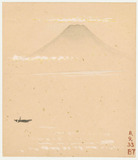Bruno Taut
Bruno Taut
Wie wird alles verlaufen? Von jetzt an ist das Reisen selbst unsere Heimat?
[How will everything turn out? Is travelling itself our home from now on? (ed. trans.)]
Bruno Taut, diary entry from 23 March 1933
| Born | on 4 May 1880 in Königsberg |
|---|---|
| Died | on 24 December 1938 in Istanbul |
| Exile | Japan, Türkei |
| Profession | Architect |
After the Nazis came to power, architect Bruno Taut was threatened with persecution as a “cultural Bolshevist”: in the First World War he designed peace monuments, wrote a pacifist manifesto and, during the November Revolution of 1918, established the “Workers’ Council for Art”.
As the head of municipal planning and construction in Magdeburg and from 1924 as an architect with his own office in Berlin, he designed and built several avant-garde residential construction projects, among these the Hufeisensiedlung in the Berlin district of Britz, which now belongs to the UN World Cultural Heritage.
In 1932 the architect, who was fascinated with the idea of communism, travelled to Moscow but already returned disappointed with developments in the Soviet Union in February of 1933. Hitler had just come to power a few days before. Taut learned that he was supposed to be arrested and so he left the country again immediately. From Switzerland, he arranged for the Japanese Association of Architects, of which he was a member, to invite him to give a lecture tour there. His hope was to continue onto the USA and travel around the world. However, the originally planned month in Japan turned out to be three years. As he was not given any real orders as an architect, he concentrated on publications about architecture theory and worked on arts and crafts, but had to rely on the financial support of family and friends. What he intended as a cultural trip became a life in exile.
In 1936, he was offered a professorship at Istanbul’s Academy of the Arts. He was able to work again as an architect there and designed several school and university buildings. Taut’s last project, the execution of which he considered to be a great honour, was designing the coffin for Atatürk’s funeral.
Selected examples of architecture:
Gartenstadt Falkenberg, Berlin (1913)
Glaspavillon für die Werkbundausstellung, Köln (1914)
Wohnsiedlung Britz („Hufeisensiedlung“), Berlin (1925)
Großsiedlung „Onkel Toms Hütte“, Berlin (1926)
Fakultät für Sprache, Geschichte und Geographie der Universität Ankara (1937)
Further reading:
Brenne, Winfried: Bruno Taut. Meister des farbigen Bauens in Berlin. Berlin: Verlagshaus Braun 2005
Hörner, Unda : Die Architekten Bruno und Max Taut. Zwei Brüder – zwei Lebenswege. Berlin: Gebr. Mann Verlag 2012
Junghanns, Kurt : Bruno Taut 1880–1938. Architektur und sozialer Gedanke. Stuttgart: b Deutsche Verlags-Anstalt 2001



